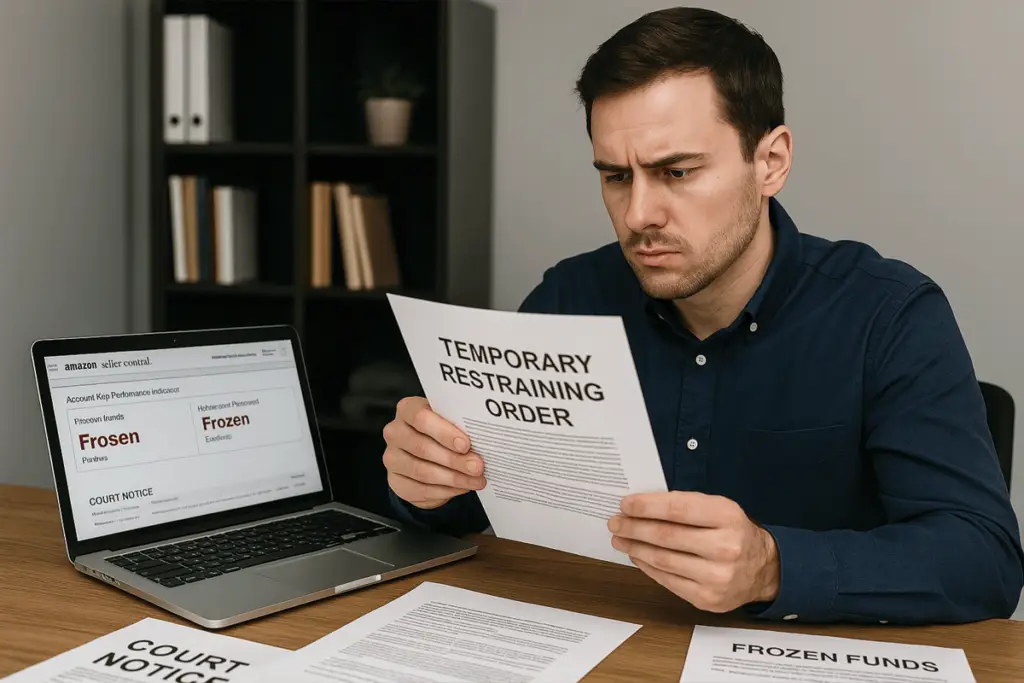What Amazon Sellers Need to Know About Temporary Restraining Orders (TROs)

Introduction
If you’re an Amazon seller, getting hit with a Temporary Restraining Order (TRO) can feel like a punch to the gut. One day, your listings are live and sales are flowing, the next, your funds are frozen and your account is part of a federal lawsuit you’ve never even heard of.
In this post, we’ll break down what a TRO is, why brand owners are using them against Amazon sellers, and how you should respond if it happens to you.
What Is a TRO?
A Temporary Restraining Order (TRO) is a court-issued order that restricts you from doing something — usually selling a product, accessing funds, or communicating with certain parties — while a legal case moves forward.
In the Amazon world, TROs are often used by brand owners or rights holders who believe a seller is:
Selling counterfeit or unauthorized goods
Violating trademarks or copyrights
Breaching a distribution agreement
These orders are typically filed in federal court and granted without notice to you, meaning you find out only after Amazon freezes your funds or takes down your listings.
Why Are Brands Using TROs Against Amazon Sellers?
Big brands and their legal teams are increasingly turning to TROs as a legal weapon to quickly shut down unauthorized sellers. They prefer this over Amazon’s internal complaint system because:
It gets faster results
It freezes your money through Amazon
It gives them leverage for a settlement
It may lead to a default judgment if you don’t respond
Many of these lawsuits are filed in the Northern District of Illinois, a court known for issuing broad TROs that affect dozens or even hundreds of sellers at once.
What Happens When You’re Hit with a TRO?
Here’s what typically happens:
You receive a notice from Amazon that your funds are frozen under a court order.
Your account may still be live, but you cannot access or withdraw money.
You’re listed as a defendant in a lawsuit, often alongside many other sellers.
You may receive an email or physical mail with a Summons and Complaint.
At this point, time is critical. If you don’t respond, the court can issue a default judgment against you, ordering you to pay damages and permanently banning you from selling those products.
Should You Be Worried?
Yes — but don’t panic. Here’s the truth:
Many TROs are part of mass enforcement campaigns that name dozens or hundreds of sellers at once.
Often, the plaintiff (brand owner) doesn’t know which sellers are infringing — they rely on bots, investigators, or bulk data.
If your products are legitimate, there may be defenses available, including the First Sale Doctrine, especially if you’re selling authentic goods lawfully obtained.
This is where a strong legal response can protect your business.
What to Do If You’re Named in a TRO
1. Don’t Ignore It
A TRO is a real court order. Ignoring it can lead to a default judgment that may include damages, injunctions, and your store being permanently frozen.
2. Get Legal Help Immediately
Time matters. You typically have 21 days or less to respond. An attorney familiar with Amazon TRO cases can help you:
Determine if you’ve been served correctly
Challenge the TRO if it’s overbroad or baseless
Work out a resolution if needed
Defend your rights in court if it proceeds
3. Gather Documentation
You’ll need to prove that your products are authentic and that you’re not violating intellectual property law. Start gathering:
Invoices from suppliers
Product images and packaging
Your product listings
Communications with distributors or brands
4. Review Your Listings
If the TRO targets specific ASINs, consider taking them down until the legal situation is resolved. Continuing to sell the product may be viewed as contempt of court.
Can You Settle or Get Dismissed?
Yes. In many cases, sellers can:
Settle with the brand for a reduced amount (sometimes just an agreement to stop selling the product)
Prove non-infringement and get dismissed from the lawsuit
Negotiate a release that lifts the freeze on your Amazon funds
Working with a firm that knows both Amazon and federal litigation, like AmazonSellersLawyer.com, gives you the best chance of a clean outcome.
How to Avoid TROs in the Future
TROs often target sellers who:
Sell branded products without clear sourcing
List under a brand name without authorization
Have poor documentation or mismatched listings
To reduce your risk:
Source from authorized distributors
Keep complete records of all purchases
Avoid using brand logos or names if not authorized
Consider moving to private label or exclusive supply chains
If you’re representing a brand and need enforcement support, visit our partner site BrandEnforcementLaw.com for brand-focused legal options.
Final Thoughts
A TRO Amazon seller case can feel overwhelming, especially when it comes without warning. But you do have rights, and with fast legal action, many sellers can settle, get dismissed, or protect their accounts.
If you’ve been served with a TRO or had your funds frozen, contact AmazonSellersLawyer.com immediately. We know how these cases work, and we can help you defend your business.
